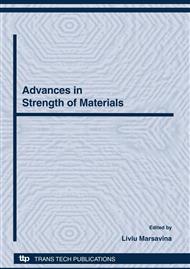p.131
p.141
p.153
p.161
p.169
p.177
p.185
p.193
p.199
Micromechanical Material Model of Wooden Veneers for Numerical Simulations of Plywood Progressive Failure
Abstract:
The plywood material is widely used in civil engineering and furniture industry as cheap, strong, and lightweight material. The progressive failure of the plywood is difficult to be modeled and predicted because of the complexity of its structure and the interaction between different modes of orthogonal damages and interlayer failure. The microstructure of the wood determines the failure of the plies. A micromechanical material model of wooden veneers is developed, which is based on a representative volume cell (RVC) taken from the tubular microstructure of the wood and represented as a truss structure with longitudinal, transverse, and diagonal bar finite elements. The damage variables prescribed for each type of the bars determine the progressive degradation of the material stiffness. The 2-D damage material model of wooden veneers is utilized as user-defined material in continuum shell elements of ABAQUS™ finite element code. The parameters of the model are determined to simulate the behavior of single veneers in tension tests in different directions of loading. Together with cohesive elements representing the interface between the plies, the suggested model can be used to simulate and analyze the progressive failure and damage interaction in the plywood. The simulations could give us better understanding of the complex failure of the plywood, the succession of the damage development and reveal the weakest link in the material. The analysis can be used for optimization of the plywood layup.
Info:
Periodical:
Pages:
169-176
Citation:
Online since:
October 2008
Authors:
Price:
Сopyright:
© 2009 Trans Tech Publications Ltd. All Rights Reserved
Share:
Citation:


